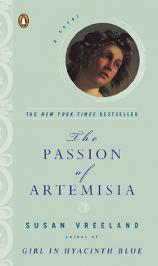The Passion of Artemisia
Review
The Passion of Artemisia
"My father walked beside me to give me courage, his palm touching gently the back laces of my bodice. In the low-angled glare already baking the paving stones of the piazza and the top of my head, the still shadow of the Inquisitor's noose hanging above the Tor di Nona, the papal court, stretched grotesquely down the wall, its shape the outline of a tear...If, while my hands were bound, I gave again the same testimony as I had the previous weeks, they would know it was the truth and the trial would be over. Not my trial. I kept telling myself that: I was not on trial. Agostino Tassi was on trial."
Artemisia Gentileschi, 18-year-old daughter of painter Orazio Gentileschi and an artist in her own right, soon discovers what many rape victims throughout the centuries have discovered: she is, indeed, on trial.
Contrary to his daughter's wishes and fueled more by anger over a missing painting than by Artemisia's violation, Orazio files an indictment against Agostino Tassi, Artemisia's painting teacher and Orazio's painting collaborator. As THE PASSION OF ARTEMISIA opens, Artemisia's predicament becomes painfully clear. It is 1612, a time when a woman's honor is all, no matter if that "honor" was ripped from her by force; a time when a daughter is her father's chattel, and property devalued requires recompense to the property owner himself.
That Artemisia rises above the ordeal of the rape trial and its communal consequences to become a well-known painter in post-Renaissance Italy says much about the strength of her character. That her basic story is true makes it even more remarkable.
Susan Vreeland, author of GIRL IN HYACINTH BLUE, has written another intelligent novel about an interesting historical character in the world of art. THE PASSION OF ARTEMISIA doesn't dwell overly long on the most well-known part of Artemisia's life --- the rape trial. Instead, Vreeland has chosen to flesh out Artemisia's story from that point forward, illuminating an artist juggling the joy and intensity of creating art with the difficulties inherent in marriage and motherhood at a time when women's choices were limited.
Artemisia marries Pietro Stiattesi, an artist, and moves to Florence, where her quotidian responsibilities do little to quench her visceral need for painting. She pushes herself to excel at her art and through perseverance and passion she comes to the attention of powerful art patrons. She makes history by becoming the first woman elected to the Accademia dell'Arte, but makes waves with her husband as, predictably, he is envious of her growing fame as an artist.
Although Artemisia suffers some remorse for the choices she makes, Vreeland makes it clear that this is a woman for whom art comes first. On her husband's artistic frustrations, Artemisia ruminates, "If a person loves something above all else, if he values the work of his heart and hands, then he should naturally, without hesitation, pour into it his whole soul, undivided and pure. Great art demands nothing less."
Artemisia goes on to make great art, much of it looking at female historical and biblical figures from a fresh perspective. Her Judith Slaying Holofernes paintings depict a woman with the physical ability and emotional determination to decapitate her enemy. Artemisia's women have muscles, dimples, and wrinkles, all the expressiveness of real-life flesh. While THE PASSION OF ARTEMISIA could have benefited from the insertion of color plates, Vreeland's descriptions of Artemisia's art and painting methods are rich in detail, giving an impression of sensuality wedded to strength in a way previously unseen in female figures. Since reading this novel, I have come across reproductions of Artemisia's paintings in another book and have found, to my pleasant surprise, that the images Vreeland spins have left me with a visual impression that is markedly true to reality.
Part of the enjoyment of THE PASSION OF ARTEMISIA derives from the inclusion of other historical figures. Artemisia's encounters with Cosimo de Medici II, Michelangelo Buonarroti the Younger (great-nephew to Michelangelo himself), and Galileo add to the novel's feeling of verisimilitude. Vreeland uses her imagination to flesh out Artemisia's associations with these famous men, resulting in some of the more delightful passages in the book. "Where art and science touch is the realm of the imagination, the place where original ideas are born, the place where both of us are most alive," declares Artemisia to Galileo at one point.
Susan Vreeland seems to have found her niche, bringing art to life through the alchemy of words imbued with the rich texture of times past. THE PASSION OF ARTEMISIA is a sensory experience; the prose leaves pigment-stained fingers and the smell of varnish in its wake.
"It would have been pleasant to talk over the evening in quiet tones --- if not with [Pietro], with someone, that man who had called me beautiful, for example --- to muse about the duke, the court, other possible clients, the music, the food, the finery, and, if it were Pietro, to undress bit by bit in candlelight while chewing on a fig, moments of the evening spilling out like plump grapes from a tipped bowl. Desirable certainly, but not essential. Painting was essential."
As writing, so it seems, is essential to Susan Vreeland, also an artist in her own right.
Reviewed by Jami Edward on December 31, 2002
The Passion of Artemisia
- Publication Date: December 31, 2002
- Genres: Fiction, Historical Fiction
- Paperback: 352 pages
- Publisher: Penguin (Non-Classics)
- ISBN-10: 0142001821
- ISBN-13: 9780142001820










